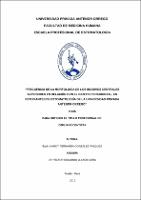Frecuencia de la morfología de los incisivos centrales superiores en relación con el biotipo periodontal, en estudiantes de estomatología de la universidad privada Antenor Orrego

Ver/
Descargar
(application/pdf: 1.391Mb)
(application/pdf: 1.391Mb)
Fecha
2019Autor(es)
Gonzalez Vasquez, Nancy Fernanda
Metadatos
Mostrar el registro completo del ítemResumen
Determinar la frecuencia de la morfología dental de los incisivos centrales
superiores en relación con el biotipo periodontal, en estudiantes de Estomatología
de la Universidad Privada Antenor Orrego.
Material y método: El presente estudio de corte transversal, descriptivo, incluye
un total de muestra de 82 estudiantes de Estomatología. Se seleccionó según los
criterios de selección. Con respecto a morfología dental se tomaron medidas de
largo y ancho de la corona de ambos incisivos centrales superiores; para obtener
la relación ancha/largo (CW/CL). Si el radio oscilaba entre 0.8mm a 1mm la corona
fue considerada corta y ancha, si oscilaba entre 0.52mm a 0.79mm se consideró
larga y estrecha. Con referencia al biotipo periodontal utilizaremos la técnica de
translucidez de la sonda. Para la confiabilidad se utilizó el método estadístico
Kappa, obteniendo una puntuación casi perfecta. Para el análisis de resultados se
empleó el programa estadístico IBM SPSS Statistics 25, para luego presentarlos en
tablas.
Resultados: Existe relación entre el biotipo periodontal y la morfología dental. La
corona corta y ancha fue la más frecuente en ambos grupos de edad y género, de
igual forma el biotipo grueso.
Conclusiones: La corona corta y ancha y el biotipo grueso fueron más frecuentes
en ambos grupos etarios, además de encontrarse relación entre biotipo periodontal
y morfología dental.
El impacto que genero este estudio nos da a conocer la frecuencia de la relación
entre ambos parámetros, dato que sirve en la práctica clínica para evaluar
pronóstico. To determine the frequency of the dental morphology of the upper
central incisors in relation to the periodontal biotype, in Stomatology students of the
Antenor Orrego Private University.
Material and method: The present cross-sectional, descriptive study includes a
total sample of 82 Stomatology students. It was selected according to the selection
criteria. With regard to dental morphology, measurements were made of the length
and width of the crown of both upper central incisors; to obtain the wide / long ratio
(CW / CL). If the radius oscillated between 0.8mm to 1mm the crown was considered
short and wide, if it oscillated between 0.52mm to 0.79mm it was considered long
and narrow. With reference to the periodontal biotype we will use the translucency
technique of the probe. For reliability, the Kappa statistical method was used,
obtaining an almost perfect score. For the analysis of results, the statistical program
IBM SPSS Statistics 25 was used, and then presented in tables.
Results: There is a relationship between the periodontal biotype and dental
morphology. The short and broad crown was the most frequent in both age and
gender groups, in the same way the gross biotype.
Conclusions: The short and wide crown and the thick biotype were more frequent
in both age groups, in addition to the relationship between periodontal biotype and
dental morphology.
The impact that this study generates will allow us to know the frequency of the
relationship between both parameters, data that is useful in clinical practice to
evaluate prognosis.
Palabras clave
Colecciones
- Estomatología [653]

